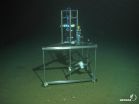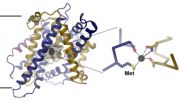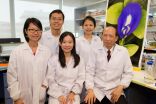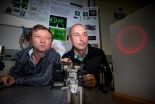(Press-News.org) A study by researchers of Ludwig-Maximilians-Universitaet (LMU) in Munich shows that infants fed on fresh rather than UHT cow's milk are less prone to infection. The authors recommend the use of alternative processing methods to preserve the protectants found in the natural product.
A pan-European study, led by Professor Erika von Mutius, Professor of Pediatric Allergology at LMU and Head of the Asthma and Allergy Department at Dr. von Hauner's Children's Hospital, reports that fresh cow's milk protects young children from respiratory infections, febrile illness and inflammation of the middle ear. Their results appear in the Journal of Allergy and Clinical Immunology. As untreated cow's milk may itself contain pathogenic microorganisms and could pose a health risk, the researchers argue for the use of processing methods that preserve the protective agents present in raw milk.
The findings are the latest to emerge from the long-term PASTURE study, which is exploring the role of dietary and environmental factors in the development of allergic illness. The study initially recruited 1000 pregnant women who were asked to document their children's diet and state of health at weekly intervals during the first year of life. "Among children who were fed on fresh, unprocessed cow's milk the incidence of head colds and other respiratory infections, febrile and middle-ear inflammation was found to be significantly lower than in the group whose milk ration consisted of the commercially processed ultra-pasteurized product," says Dr. Georg Loss of Dr. von Hauner's Hospital, first author of the new paper. Ingestion of farm milk reduced the risk of developing these conditions by up to 30%, and the effect was diminished if the milk was heated at home before consumption. Conventionally pasteurized milk retained the ability to reduce the risk of febrile illness, while exposure to the higher temperatures used in UHT processing eliminated the effect altogether. Importantly, the positive impact of raw milk could be clearly separated from the confounding effects of other elements of the children's nutrition.
Impact on inflammation
"The effects of diverse milk treatments are presumably attributable to differentially heat-resistant components present in fresh milk. Compounds that are sensitive to heating seem to play a particularly important role in protection against respiratory-tract and ear infections," says Loss.
At the end of the first year of life, blood samples were obtained from the children enrolled in the study, and tested for biochemical indicators of immunological function. Infants fed on unprocessed milk were found to have lower levels of the C-reactive protein, which is a measure of inflammation status. "Other studies have shown that higher levels of inflammation are related to the subsequent emergence of chronic conditions such as asthma and obesity. Consumption of unprocessed milk may therefore reduce the risk of developing asthma," Loss explains.
Industrial processing of milk involves short-term heating of the raw product. Conventionally pasteurized milk has been exposed to temperatures of 72-75°C for 15 seconds, while ultra-pasteurized milk undergoes heating at around 135°C for a few seconds. The latter is also homogenized to disperse the milk fats, which prevents the formation of cream. "Consumption of unprocessed milk itself is not entirely without risk," says Loss. Indeed, untreated milk may contain pathogenic bacteria that cause serious illnesses. Examples include the enterohemorrhagic Escherichia coli (EHEC) strains that are associated with severe diarrhea and kidney failure, and the microorganisms that cause listeriosis and tuberculosis. The researchers therefore suggest that alternative processing methods are needed for the industrial treatment of raw milk. "With novel, milder treatments one could produce milk that is free of pathogenic microorganisms but retains the protective agents found in fresh milk," says Loss.
The perks of country life
In addition to fats and carbohydrates, cow's milk contains proteins that can modulate the function of the immune system. "In many respects, the composition of cow's milk is similar to that of human milk," says Loss. It has long been known that breast-feeding protects infants from infection, although how milk actually affects the early immune function remains unclear. It is possible that some of the factors involved interact directly with viruses or that they promote the development of a healthy immune system by altering the composition of the gut microflora.
Feeding young children with cow's milk is also contentious because it can provoke allergic reactions. Among the children who participated in the PASTURE study only 2% had developed an allergy to milk or other food items prior to their first birthday.
That living in the country has positive effects on the immune system has been demonstrated in several previous studies. Together these investigations show, as Erika von Mutius notes, that "children who grow up on traditional dairy farms are least likely to develop allergies."
The 1000 pregnant women involved in the PASTURE study were recruited in rural areas of Bavaria, Finland, France, Switzerland and Austria, and approximately half of them live on farms. As well as monitoring maternal nutrition during pregnancy, the study will regularly assess their children's health and developmental status during the first 10 years of life, in order to elucidate the role of environmental factors in the etiology of allergic disease. The study is being carried out by teams at LMU and the German Center for Lung Research, universities in Ulm, Marburg, Basel, Helsinki, Kuopio (Finland) and Besançon (France) and children's hospitals in St. Gallen (Switzerland) and Schwarzach (Austria).
INFORMATION:
A desert at the bottom of the sea? Although the waters of the North Sea exchange about every two to three years, there is evidence of decreasing oxygen content. If lower amounts of this gas are dissolved in seawater, organisms on and in the seabed produce less energy – with implications for larger creatures and the biogeochemical cycling in the marine ecosystem. Since nutrients, carbon and oxygen circulate very well and are processed quickly in the permeable, sandy sediments that make up two-thirds of the North Sea, measurements of metabolic rates are especially difficult ...
To make a decision for or against adjuvant chemotherapy, a test to measure the concentrations of the biomarkers uPA and PAI-1 in the tumour tissue is available for breast cancer patients. However, as suitable studies are lacking, it remains unclear for patients with an intermediate risk of recurrence which benefit or harm a treatment strategy based on this test may have for them. This is the result of the final report published by the Institute for Quality and Efficiency in Health Care (IQWiG) on 20 October 2014.
Adjuvant systemic treatments aim to prolong survival
Even ...
Individuals who are genetically predisposed to obesity may soon have a therapeutic solution to combat their condition. A research team led by scientists from the National University of Singapore (NUS) has identified several potent inhibitors that selectively target FTO, the common fat mass and obesity-associated gene. These FTO-specific inhibitors pave the way for the development of novel anti-obesity drugs and treatments.
The research, led by Assistant Professor Esther Woon from the Department of Pharmacy at the NUS Faculty of Science, along with colleagues from the ...
In a world of matinee idols and cover girls it's easy to assume that humans want their men to be manly and their women womanly.
But a groundbreaking new study suggests that, rather than being a preference passed down through a long process of social and sexual selection, it's a relatively new habit that has only emerged in modern, urbanised societies.
A team of psychologists, anthropologists and biologists, led by Brunel University London, surveyed 12 populations around the world, from the primitive to the highly developed.
Surprisingly, only in the most industrialised ...
Iron is the most abundant trace element in humans. As a cofactor of certain proteins, it plays an essential role in oxygen transport and metabolism. Due to the major importance of iron in a wide variety of cellular processes, and the harm caused by its uncontrolled accumulation in the body, its uptake and storage is strictly regulated. In mammals, iron is imported into cells by the membrane transport protein DMT1. Mutations of DMT1, which affect its transport properties, lead to iron-related metabolic disorders such as anemia and the iron storage disease hemochromatosis.
Ines ...
How did life originate? And can scientists create life? These questions not only occupy the minds of scientists interested in the origin of life, but also researchers working with technology of the future. If we can create artificial living systems, we may not only understand the origin of life - we can also revolutionize the future of technology.
Protocells are the simplest, most primitive living systems, you can think of. The oldest ancestor of life on Earth was a protocell, and when we see, what it eventually managed to evolve into, we understand why science is so fascinated ...
The drug combination umeclidinium/vilanterol (trade name Anoro) has been approved since May 2014 for adults with chronic obstructive pulmonary disease (COPD). In an early benefit assessment pursuant to the Act on the Reform of the Market for Medicinal Products (AMNOG), the German Institute for Quality and Efficiency in Health Care (IQWiG) examined whether this drug combination offers an added benefit over the appropriate comparator therapy.
According to the findings, an added benefit is not proven: For patients with moderate COPD severity and patients with fewer than ...
Scientists at Nanyang Technological University (NTU Singapore) have discovered a new molecule which can join together chains of amino acids – the building blocks of protein.
Only three other known molecules have been discovered to be able to perform this function, which is an important process in the development of new drugs. A key difference is that the new molecule is able to do the same process 10,000 times faster than the other three and "cleanly" without leaving any residue behind.
This new molecule, which is a type of catalyst or enzyme, was derived from ...
Researchers at VTT Technical Research Centre of Finland, the University of Turku and the University of Oslo have discovered a previously unknown molecular-level mechanism that may partly explain the increased growth of cancer cells. The study, published in the British Journal of Cancer, showed that high levels of miRNA-378a-5p molecule cause cell division anomalies. This renders the number of chromosomes in cancer cells abnormal, which is known to promote growth and the spread of cancer. In addition, the researchers discovered that elevated miRNA378a-5p levels in breast ...
Laser physicists have built a tractor beam that can repel and attract objects, using a hollow laser beam that is bright around the edges and dark in its centre.
It is the first long-distance optical tractor beam and moved particles one fifth of a millimetre in diameter a distance of up to 20 centimetres, around 100 times further than previous experiments.
"Demonstration of a large scale laser beam like this is a kind of holy grail for laser physicists," said Professor Wieslaw Krolikowski, from the Research School of Physics and Engineering at The Australian National ...



